Menu
Physics Lesson 12.10.3 - The Human Eye
Please provide a rating, it takes seconds and helps us to keep this resource free for all to use
Welcome to our Physics lesson on The Human Eye, this is the third lesson of our suite of physics lessons covering the topic of Power of Lenses. The Human Eye, you can find links to the other lessons within this tutorial and access additional physics learning resources below this lesson.
The Human Eye
The human eye is a wonderful natural structure that helps us see the world in a colourful way. It is made up by a number of components, each of them having a specific function. Let's take a closer look to this important organ of our body.
a) Parts of the eye
The eye has a spherical shape called eyeball, most of which has a white colour when healthy. The cornea is the clear front surface of the eye. It lies directly in front of the iris and pupil, and it allows light to enter the eye.
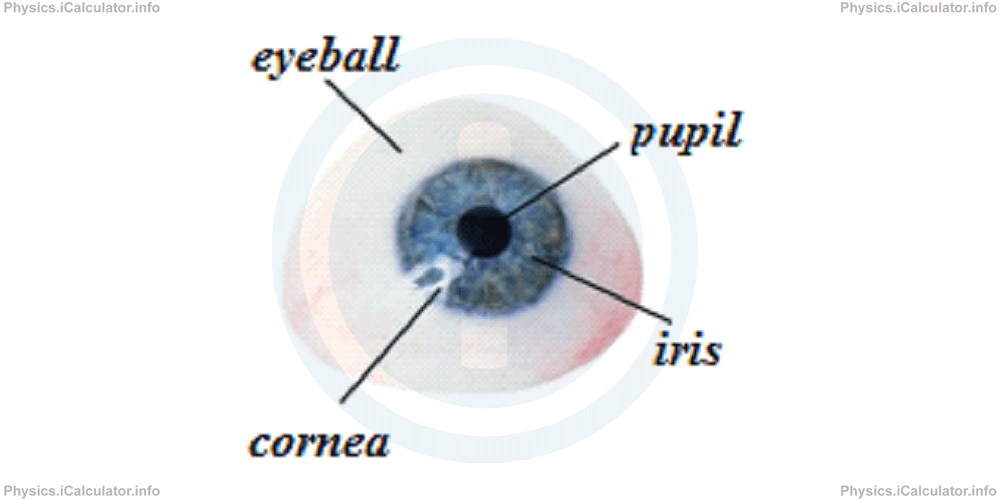
Attached to the pupil there is a converging lens, which refracts the light rays entering the eye, forming an inverted image on the retina, at the back of the eyeball.
The retina has about 130 million light-sensitive cells! These cells produce electrical signals when light falls upon them. The optic nerves carry these signals from the eye to the brain. The brain then converts the signals into upright image. Although the image on the retina is inverted, we don't see the world upside down!
Ciliary muscle is a circular muscle that enables the lens to change shape for focusing.
The inside of the eyeball is filled with a watery liquid as shown in the figure below.
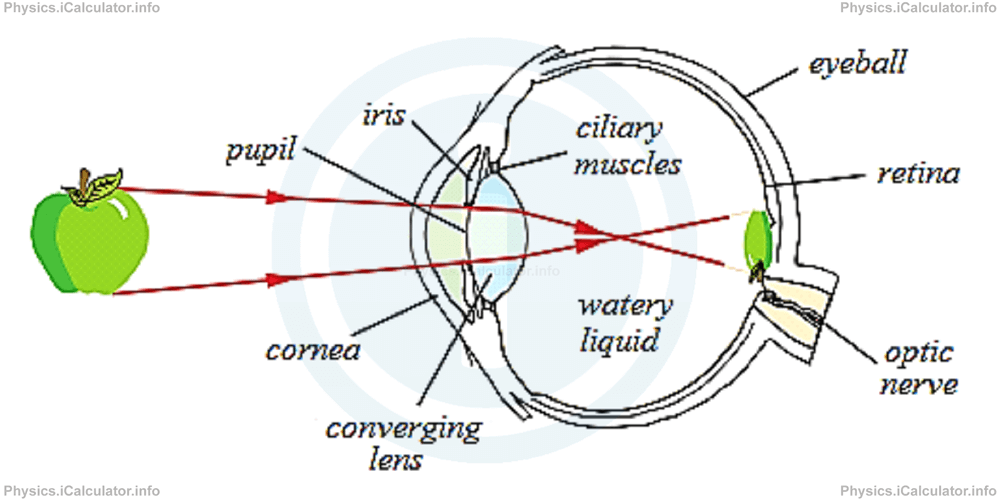
b) Night and day
The light intensity entering the eye is controlled by the iris. If there is too much light, the iris enlarges, making the pupil smaller. In this way, the light intensity entering the eye decreases. This occurs during the day, in places exposed to sunlight. During the night the reverse process does occur, i.e. the iris shrinks, making the pupil larger. As a result, more light enters the eye and therefore, the light intensity increases.
c) The focusing eye
The eye lens is flexible, i.e. it becomes thicker or thinner as needed. This is made possible by the action of ciliary nerves as stated earlier. When the eye lens changes thickness, its focal length also changes. Thus, the eye can make focusing adjustments for objects at various distances. This property of eye is known as eye accommodation.
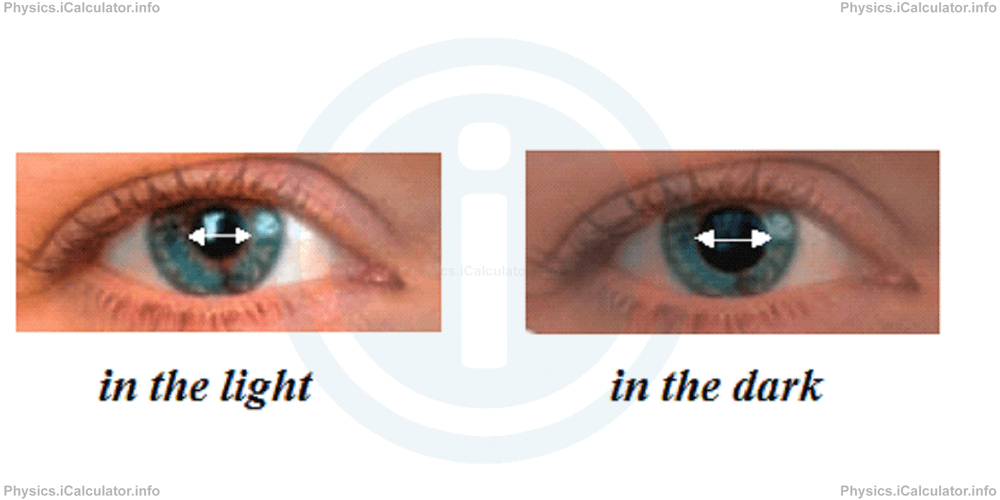
Practically, a person with normal vision has an infinite distance of eye accommodation because he/she may see objects at very high distances without having any trouble. Therefore, the far point of normal people is at infinity. On the other hand, the nearest point in which the eye can accommodate effortlessly is known as the near point. For normal people the near point is 25 cm. This means the eye can be damaged when we try to see objects closer than 25 cm, because this causes tension in the eyes.
d) Eye defects
Many people have trouble in seeing clearly the objects around them. Their vision is blurred when it should not be so. This phenomenon occurs due to many factors, both inherited and acquired, and it is known as eye defect.
Basically, there are six types of eye defects:
1. Long-sightedness (Hyperopia)
Some people see distant objects clearly but they cannot see nearby objects with the same clarity. This occurs either because their eyeballs are shorter than normal, or because their eye-lenses are too thin. Such people are said to be long-sighted. In this pathology, light rays entering patients' eyes from a near object are focused behind the retina. A converging lens placed before the eye (in the form of optical glasses) can correct this defect. It changes the direction of incident light to the eye by bringing them closer to each other, so that the eye-lens forms an image exactly on the retina, as shown in the figure below.
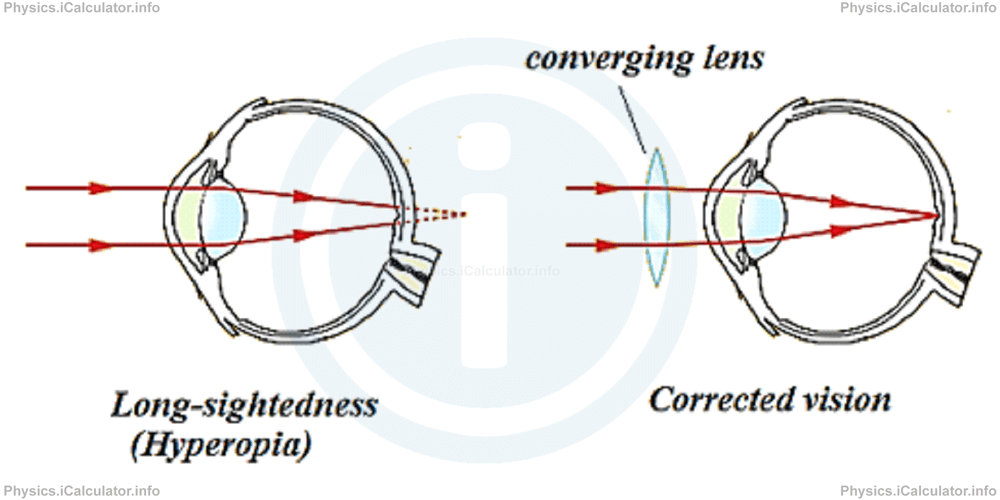
2. Near-sightedness (Myopia)
Some people see nearby objects very clearly but they cannot see distant objects with the same degree of clarity. These people are said to be near-sighted. Their eyeballs are either longer than normal, or their eye-lenses are too thick. As a result, the light rays from a distant object are focused in a position that is located before the retina. A diverging lens in the form of optical glass is used to correct this kind of defect. This lens diverges the light rays so that the eye-lens forms an image exactly on the retina, as shown in the figure below.
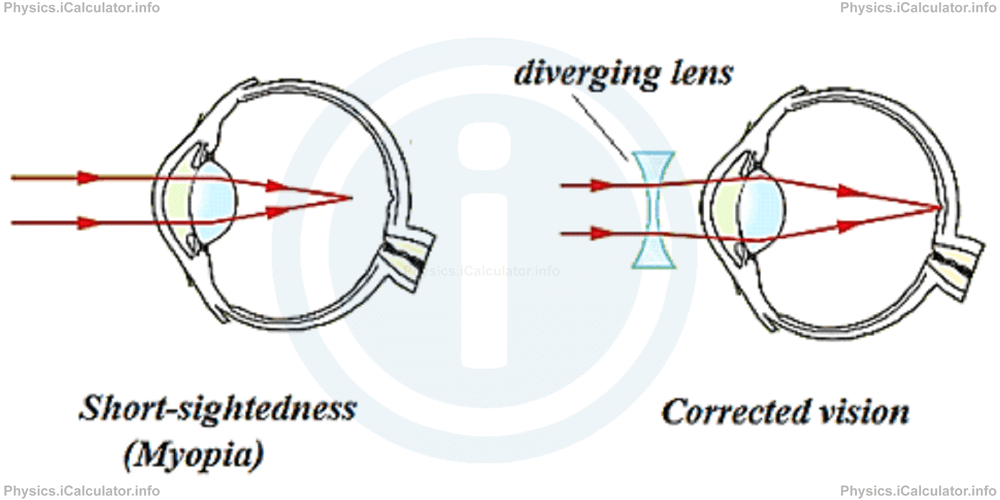
Example 3
The typical distance between the eye-lens and retina is 2.5 cm. A patient goes to an oculist who discovers that the light rays converge at a distance of 2.8 cm from the eye-lens, as shown in the figure.
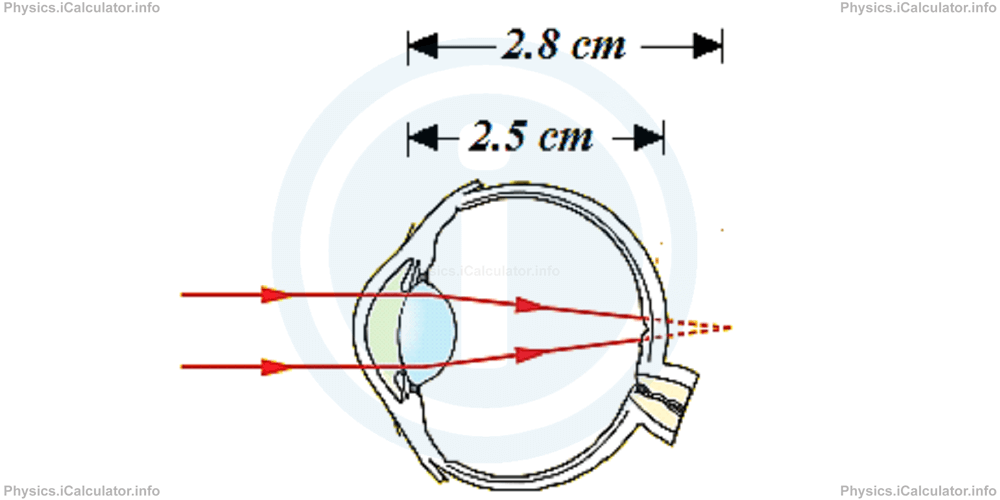
- What type of eye-defect does the patient have?
- What type of optical glasses must the doctor prescribe to him? (Include numerical values in your answer). Suppose the optical glasses must be at 1 cm distance from the eye-lenses.
Solution 3
- The patient is long-sighted because the rays converge beyond the retina. Therefore, his eye-defect is the hyperopia.
- The doctor must prescribe optical glasses containing converging lenses, in order to make the light rays converge at a shorter distance from the eye lens, i.e. make them converge on the retina.
We must use the formula of combined lenses power in order to find the focal length of the converging lens needed (and therefore, the power of the diverging lens to be used in the optical glasses prescribed by the doctor). We have the following clues:
Fcombined = F = 2.5 cm = 0.025 m
d = 1 cm = 0.01 m
Flens = F1 = ?
1/F = 1/F1 + 1/F2 - d × (1/F1 × 1/F2 )
Substituting the known values, we obtain
1000/25 = 1/F1 + 1000/28 - 10/28 × F1
40 - 1000/28 = 28/28 × F1 - 10/28 × F1
1120/28 - 1000/28 = 18/28 × F1
120/28 = 18/28 × F1
120 = 18/F1
In this way, we obtain for the focal length of the optical glasses needed:
= 0.15 m
= 15 cm
This means the doctor must prescribe optical glasses of power
= 1/0.15 m
= +6.67 dioptres
to the patient, in order to correct his vision.
3. Colour-blindness
This is another anomaly of the eye, in which the patient is not able to distinguish the colours of objects. The cells on normal peoples' retina are sensitive to colours. As a result, the objects appear coloured. However, a colour-blind person cannot recognize some colours. A colour-blind person is not able to make distinction between red and green - both of them look the same to him/her!
Try to read the hidden number in the figure.
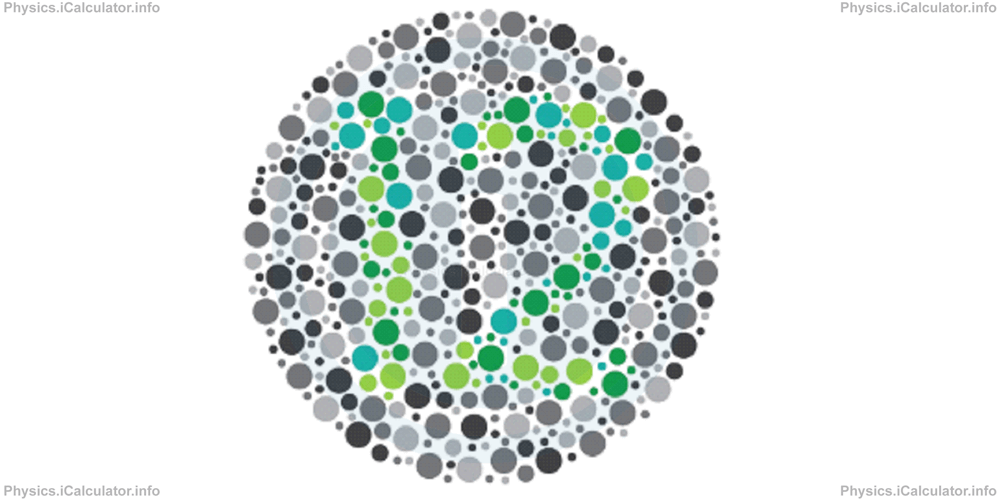
If you are able to read the number 12, then you are not colour-blind.
Colour-blind people must avoid working in jobs where the colours are important such as in painting, fashion industry, etc.
4. Astigmatism
This pathology is a result of an irregularly shaped cornea or eye-lens. If the eye-lens or cornea are not perfectly spherical, the eye can form a correct image only in some directions, but not in others. To correct this defect, cylindrical lenses are typically used.
The following figure shows a simple test for astigmatism. If the figure looks regular, i.e. the distance between the lines looks the same, then your vision is regular, otherwise you should visit a doctor to see if you have any astigmatism symptoms.
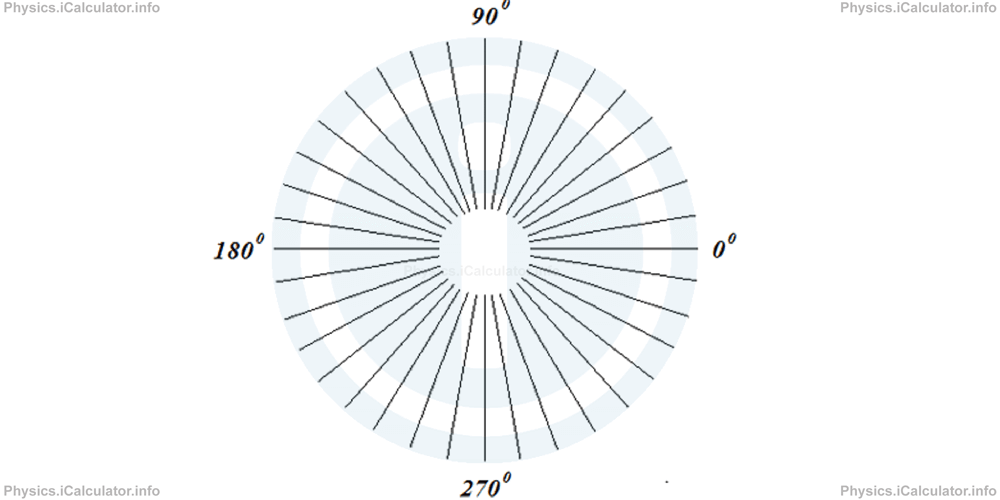
5. Cataract
Cataract occurs when the vision becomes cloudy. Such a pathology can be corrected through a surgical intervention.
6. Blindness
Blindness represents a pathology involving a lack of vision. It may also refer to a loss of vision that cannot be corrected with glasses or contact lenses. Partial blindness means the patient has very limited vision. Complete blindness means the patient cannot see anything and is not able to see any light. (Most people who use the term "blindness" mean complete blindness.)
You have reached the end of Physics lesson 12.10.3 The Human Eye. There are 3 lessons in this physics tutorial covering Power of Lenses. The Human Eye, you can access all the lessons from this tutorial below.
More Power of Lenses. The Human Eye Lessons and Learning Resources
Whats next?
Enjoy the "The Human Eye" physics lesson? People who liked the "Power of Lenses. The Human Eye lesson found the following resources useful:
- Sight Feedback. Helps other - Leave a rating for this sight (see below)
- Optics Physics tutorial: Power of Lenses. The Human Eye. Read the Power of Lenses. The Human Eye physics tutorial and build your physics knowledge of Optics
- Optics Revision Notes: Power of Lenses. The Human Eye. Print the notes so you can revise the key points covered in the physics tutorial for Power of Lenses. The Human Eye
- Optics Practice Questions: Power of Lenses. The Human Eye. Test and improve your knowledge of Power of Lenses. The Human Eye with example questins and answers
- Check your calculations for Optics questions with our excellent Optics calculators which contain full equations and calculations clearly displayed line by line. See the Optics Calculators by iCalculator™ below.
- Continuing learning optics - read our next physics tutorial: Features of Light
Help others Learning Physics just like you
Please provide a rating, it takes seconds and helps us to keep this resource free for all to use
We hope you found this Physics lesson "Power of Lenses. The Human Eye" useful. If you did it would be great if you could spare the time to rate this physics lesson (simply click on the number of stars that match your assessment of this physics learning aide) and/or share on social media, this helps us identify popular tutorials and calculators and expand our free learning resources to support our users around the world have free access to expand their knowledge of physics and other disciplines.